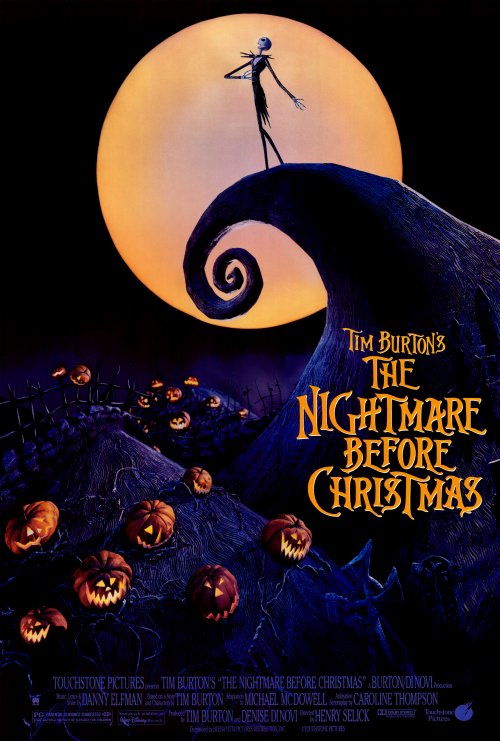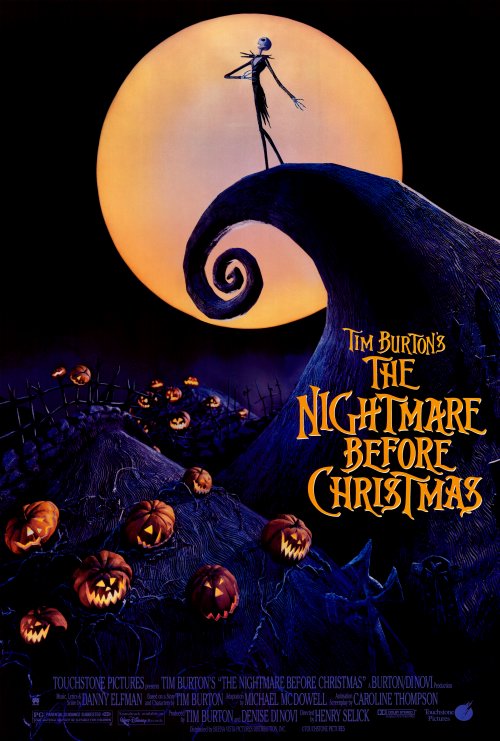This review by Jessica Critcher previously appeared at Bitch Flicks as part of our series on Animated Children’s Films.
 |
| The Nightmare Before Christmas (1993) |
This Halloween my husband and I stayed in and cuddled up with Funfetti cupcakes and a movie. We capped off our week-long 90’s Halloween movie marathon with a favorite from my childhood, The Nightmare Before Christmas. I’ve probably seen this film a hundred times. I know all of the songs by heart. I remember watching it on VHS when it first came out, which is making me feel increasingly old. But as is the case with several things from my childhood, some of the nostalgia wears thin when subjected to critical analysis.
For one thing, as I would love to describe to my five-year-old self, the film doesn’t pass the Bechdel test. To refresh your memory, passing the Bechdel test means a film has to have two female characters (with names) who talk to each other about something besides men. That’s it, and yet even this very basic requirement is usually too much for Hollywood to handle. Sally the rag doll and Shock, the witch trick-or-treater, only talk to men. According to Wikipedia, the two witches aren’t given names in the film, only later in a video game. But even without the name part, they only talk to and about Jack. This sends the message to boys and girls alike that female characters do not have anything substantial to contribute to the dialogue or the plot of the film. Girls and women do not, apparently, have anything interesting or relevant to say to one another, and children internalize that very deeply. While this was probably unintentional, the effect is still the same.
 |
| Shock |
Maybe you’re thinking that’s a bit harsh. After all, the named female characters do seem to have quite a bit of agency. Shock is frustrated with her “dumb” cohorts and seems to be the brains of the outfit. She is quick to point out flaws in their plans and ultimately decides the best method to kidnap Santa Claus. But her development as a character ends with that scene. Shock is a naughty child motivated by nothing apart from her desire to do mischief. While there is nothing wrong with this type of character per se, there is something wrong with the fact that she represents half of the named female cast. And, while Shock is admittedly fun, I feel she does not do justice to Catherine O’Hara’s talent.
This brings me to Sally, also voiced by O’Hara. On the surface, Sally is the perfect heroine. She is constantly outsmarting her doddering caretaker, Doctor Finklestein. She repeatedly slips “deadly nightshade” into his food, putting him to sleep so she can wander free. Her knowledge of herbs and potions is a serious inspiration to Jack in his quest for the meaning of Christmas. He even asks her to make his “Sandy Claws” suit, because she is the only one “clever enough” to do it. She has the foresight to know his plan will be a disaster, so she tries to stop Christmas with fog juice. Then, she rushes to the aid of Santa Claus, leading him to tell Jack, “The next time you get the urge to take over someone else’s holiday, I’d listen to her! She’s the only one who makes any sense around this insane asylum!” Jack eventually realizes that he was a fool not to listen to Sally, or notice her affection for him.
 |
| Sally |
So, my five-year-old self loved Sally mostly because she is smart and resourceful. But Sally isn’t defined by her intelligence. She is defined by her relationships to the men in the story. Five-year-old me never bothered to question why she was the property of her creepy father in the first place. And while Jack is motivated by his role in the community and a quest for self-discovery, Sally is only driven by her desire to be with Jack. After Doctor Finklestein declares Sally to be too much trouble, he sets about building a new female companion who won’t disagree with him or run away. Sally’s world, which revolves around being with Jack and taking care of him, is at peace when he finally notices her and wants to be with her.
I still like the film. It gets me feeling all fuzzy inside and it serves the double purpose of celebrating Halloween and getting me amped up for Christmas. But I’m not five anymore. We live in a very complicated world where many changes need to take place, and girls and boys need to see these changes in the media they consume. Maybe someday Tim Burton could revamp the film and have Sally take over as mayor of Halloween Town (because seriously, that guy is an incompetent idiot). Maybe Shock could apprentice under the two witches and learn a useful trade to put her wits to better use. Maybe somewhere in Halloween Town, two women could talk to each other about something—anything—and the town could join us all in the 21st century. That sounds more like a Halloween classic I would want children to see.
———-
Jessica Critcher loves to write about feminism and gender issues, and she is a regular contributor to Gender Focus. While she loves living in Boston, she often misses Honolulu, where she earned her bachelor’s degree in English (and forgot that there was such a thing as snow).

